HR professionals on lean teams wear many hats, often balancing operational tasks with strategic initiatives. Making a meaningful impact with limited resources is both a challenge and an opportunity. The key? Aligning HR priorities with business objectives to drive measurable results.
This workbook helps you translate insights from the on-demand “Strategic HR for lean teams: Aligning people and business objectives“ webinar into actionable steps tailored to your organization.
This workbook helps you:
- Connect HR programs directly to business goals
- Communicate HR’s value effectively to leadership
- Position HR as a strategic partner in company decision-making
How to get the most out of this workbook
This workbook is designed to be your practical, interactive companion as you navigate strategic HR for lean teams. Whether you follow along with the webinar or use it as a standalone tool, you’ll find actionable exercises to help you align HR initiatives with business goals and maximize impact with limited resources.
- Complete the exercises as you follow along with the webinar or at your own pace
- Use it digitally or print it out—tables and templates are designed for easy editing
- Refer back to it as you implement strategies in your organization
<<Download the workbook in document format to start your alignment strategy.>>
Strategizing alignment: Why strategy matters for small HR teams
What does it mean to be a lean HR team? A lean HR team operates with fewer resources while managing a high volume of work. Often, there are more initiatives than time or people power to execute them, making prioritization essential. The challenge is balancing daily operational tasks with long-term strategic goals to maximize impact.
Want to watch the webinar? Watch on-demand here
Without strategic alignment, HR can become a game of whack-a-mole—constantly reacting to problems without stepping back to assess their actual impact. This can lead to a cycle where urgent, low-impact tasks take precedence over less immediate but highly strategic priorities, making it difficult for HR to demonstrate long-term value and drive meaningful change.
When HR is in a reactive state:
- Teams chase urgent issues instead of solving meaningful problems
- Missed opportunities weaken HR’s business influence
- HR struggles to focus on engaging and strategic work
However, with a proactive strategy, even small HR teams can drive major business outcomes while still handling core HR functions.
When HR is in a proactive state:
- HR programs align with long-term business goals
- Data-driven decisions help predict trends and mitigate issues early
- HR creates value-driven programs that impact employees and leadership
Activity: Identifying HR’s influence on business outcomes
Take a moment to reflect on your recent HR programs. Were they reactive (responding to immediate problems) or proactive (aligned with long-term business goals)?
Step one: List HR programs
- List the recent HR programs you worked on
- Assess how well each initiative aligned with organizational goals
Write your responses below (or download the Word doc to use as a workbook):
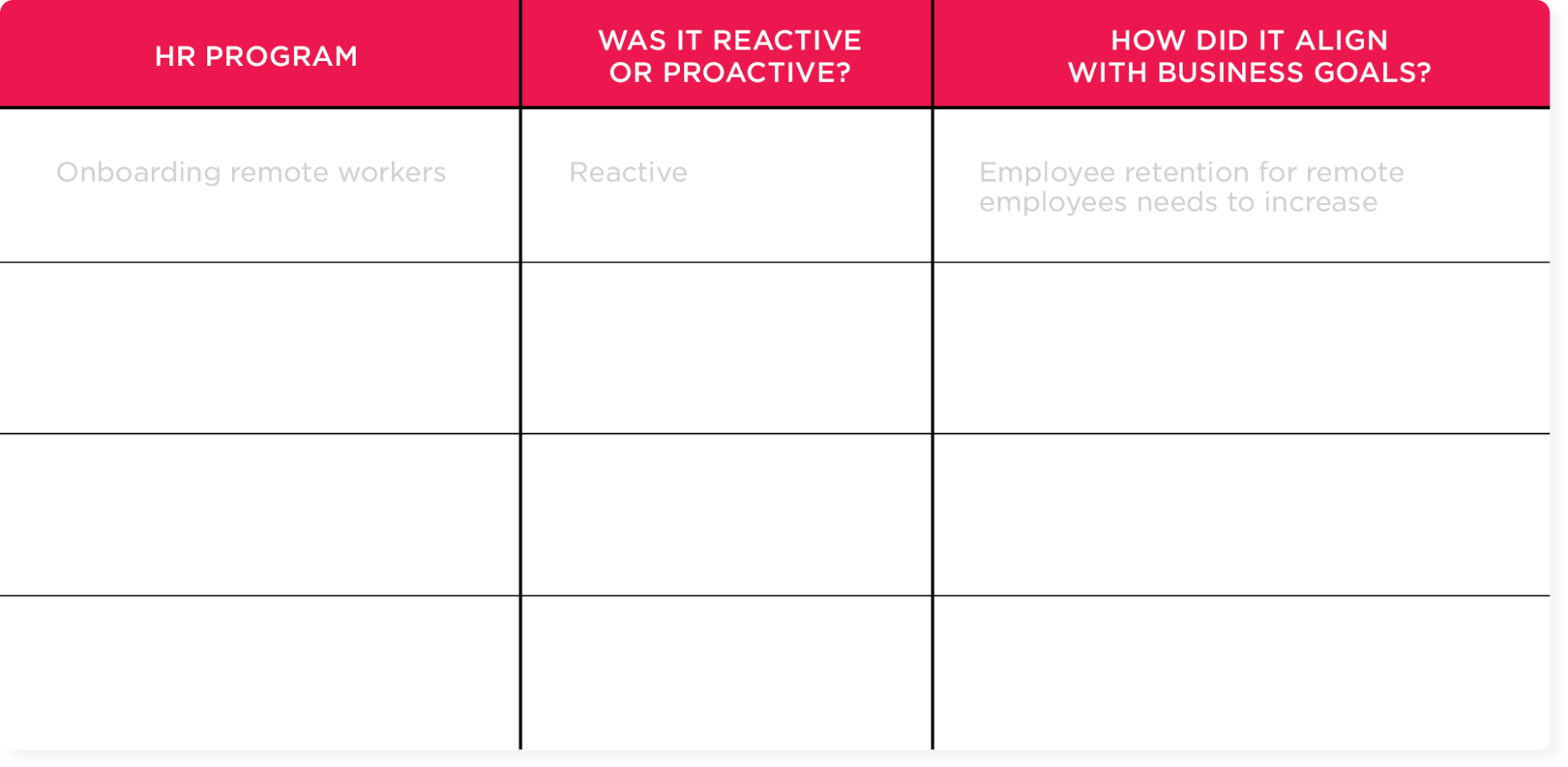
Activity: Matching HR programs to business outcomes
Most HR professionals are unsure of why they need the connection between HR programs and business outcomes. A recent study found that over 50 percent of organizations offer services and programs not aligned with a specific business purpose. Moreover, fewer than 15 percent of HR organizations can say how their policies, practices, or programs are designed to impact business goals. In this activity, you will connect some of your everyday HR activities to the larger business outcomes.
Step one: Align programs and outcomes
Match each HR program with the business outcomes it supports.
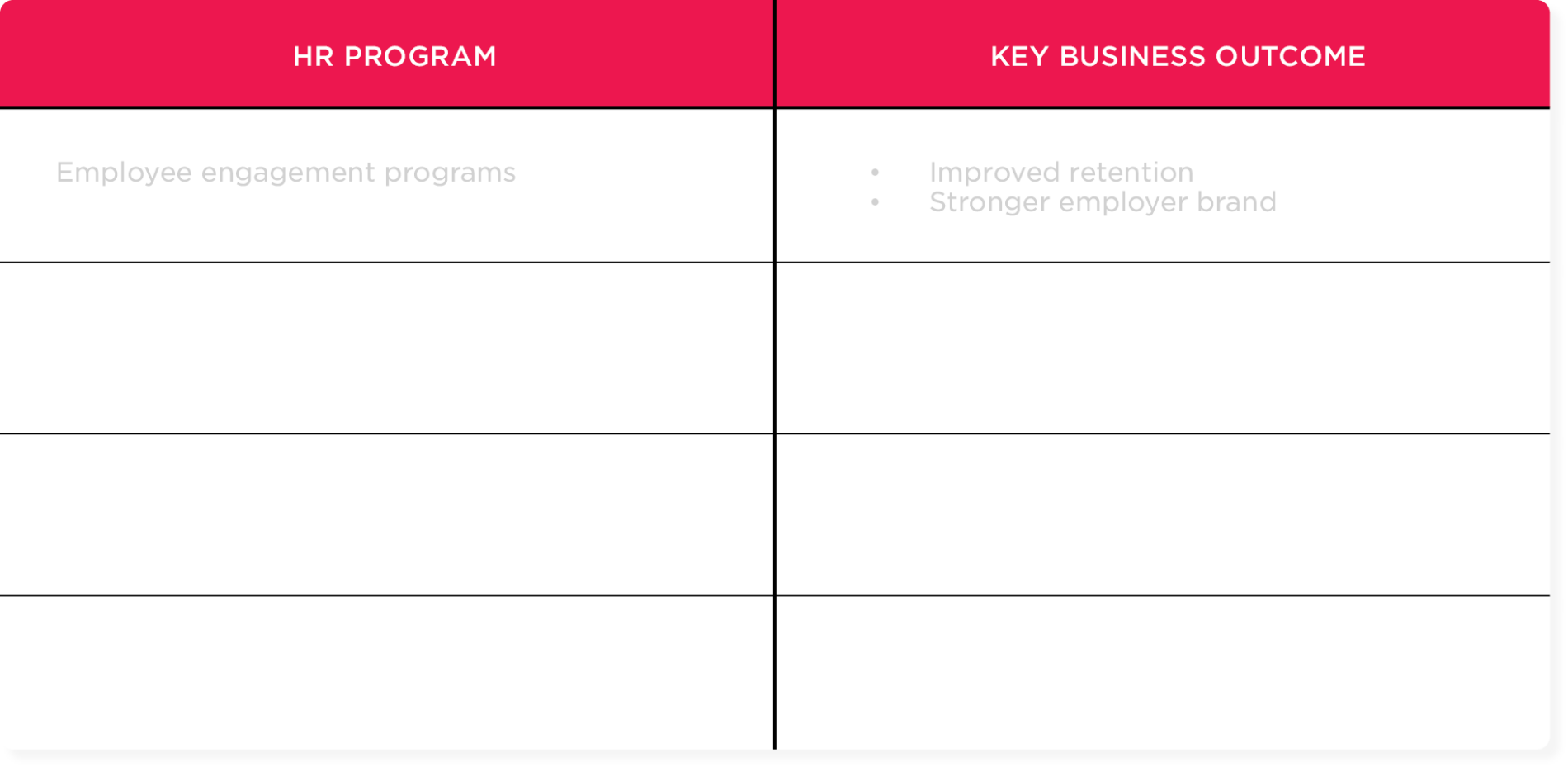
Building strategic alignment
Every HR initiative should begin with a deep understanding of the company’s broader goals. After all, every organization, except non-profits, exists to generate revenue. For some teams, like sales, the direct connection between their work and a bottom-line metric like revenue is easy to see. However, aligning people’s strategy with business priorities takes a bit more effort for HR.
The key? Start by understanding what your leadership is focused on.
- Is the priority revenue growth or cost reduction?
- Are they focused on innovation or scaling an existing business?
Knowing leadership’s focus helps you align HR programs with what’s important to them and, therefore, what’s important to the business.
For example, a subscription-based SaaS company probably cares deeply about customer retention. Leadership monitors customer satisfaction metrics to anticipate whether retention will increase or decline. In this case, HR programs such as employee engagement and retention are a perfect fit.
To further emphasize the business value, a Gallup study found that businesses with high employee engagement experience 10 percent higher customer loyalty and a 20 percent increase in sales. When HR prioritizes employee engagement and retention, it directly drives customer satisfaction and long-term business growth.
Activity: Align HR programs and business objectives
Step one: List your HR programs

Step two: Map your business to HR programs
Identify your company’s top business objectives to align HR with business strategy.
- Partner with leadership to understand their top three business objectives
- Identify the HR programs that align with those goals
Write your responses below:

Step three: Connect your HR programs to business success
Maximizing HR ROI for lean teams means proactively linking HR programs to business outcomes. This may be the most complex step for HR managers to outline, and it may take a bit more time to think through, but it is the essential step that will lead us to the crucial correlation between HR and business.
Fill in your answers below to document the process of matching each HR program with its measurable business impact.
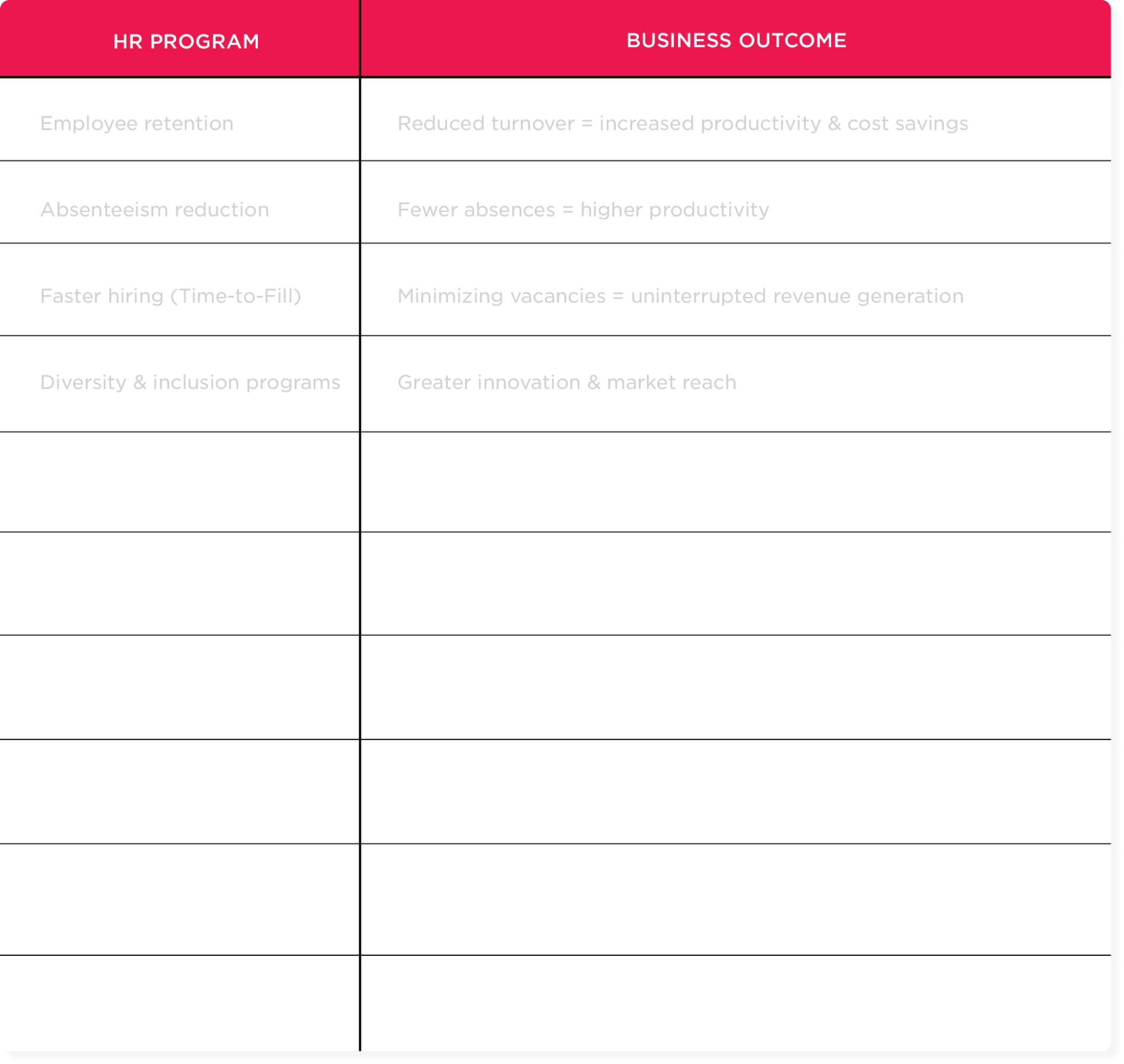
Step four: Structuring a value chain
Once you have mapped out business outcomes and HR programs, it’s time to articulate how HR influences business success. That’s where the value chain comes into play.
A value chain clearly shows the relationship between an HR program and all the steps needed to achieve a business outcome. For example:
- Engaged employees → Satisfied customers → Increased retention → Higher revenue
The longer or more complex the value chain, the more work HR needs to do to illustrate its impact—especially for initiatives like engagement, which don’t have an immediate financial ROI.
Depending on different business models, some value chains will have a stronger, more measurable impact than others. Choosing the right HR metrics and ensuring they align with your business’s unique model is essential.
For example, employee engagement has a stronger business impact when a company has annual or quarterly renewals (e.g. SaaS companies where consistent customer satisfaction is critical for retention). However, if renewals happen every 10 years (e.g. commercial real estate), the immediate impact of engagement on revenue may be less direct. In such a case, the value of engagement might be better connected to a metric like speed or size of deal/renewal as engaged employees invest more effort in more efficient processes.
To start building your value chains, take the HR programs you listed in the previous step above (Step three: Connect your HR programs to business success) and break them down into the “chains” that link your HR program to business success. Note that each value chain may have only one link or more than two. You should add as many links to your chain as needed to show that your HR program leads to the outcome in a meaningful way that stakeholders will understand.
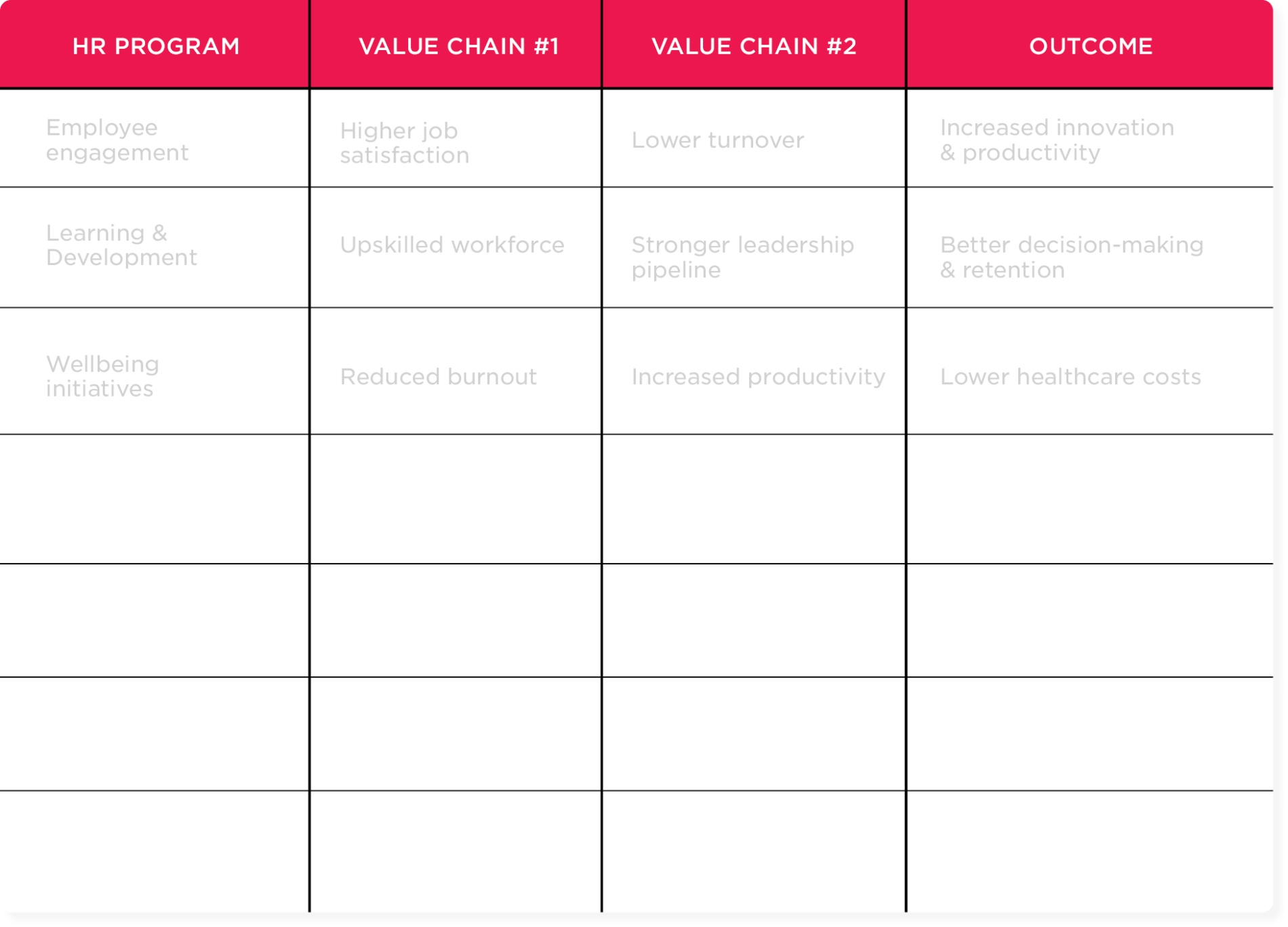
Step five: Adding data to build your case
Without data to support HR’s role in business success, even the most impactful programs can be deprioritized. But you don’t need to prove HR’s impact on revenue down to the last dollar. Instead, use external research to validate general HR-business links and internal data to show your HR programs are moving the right metrics associated with the steps on your value chains.
Identify which HR data points you can use to measure the impact on your value chains.
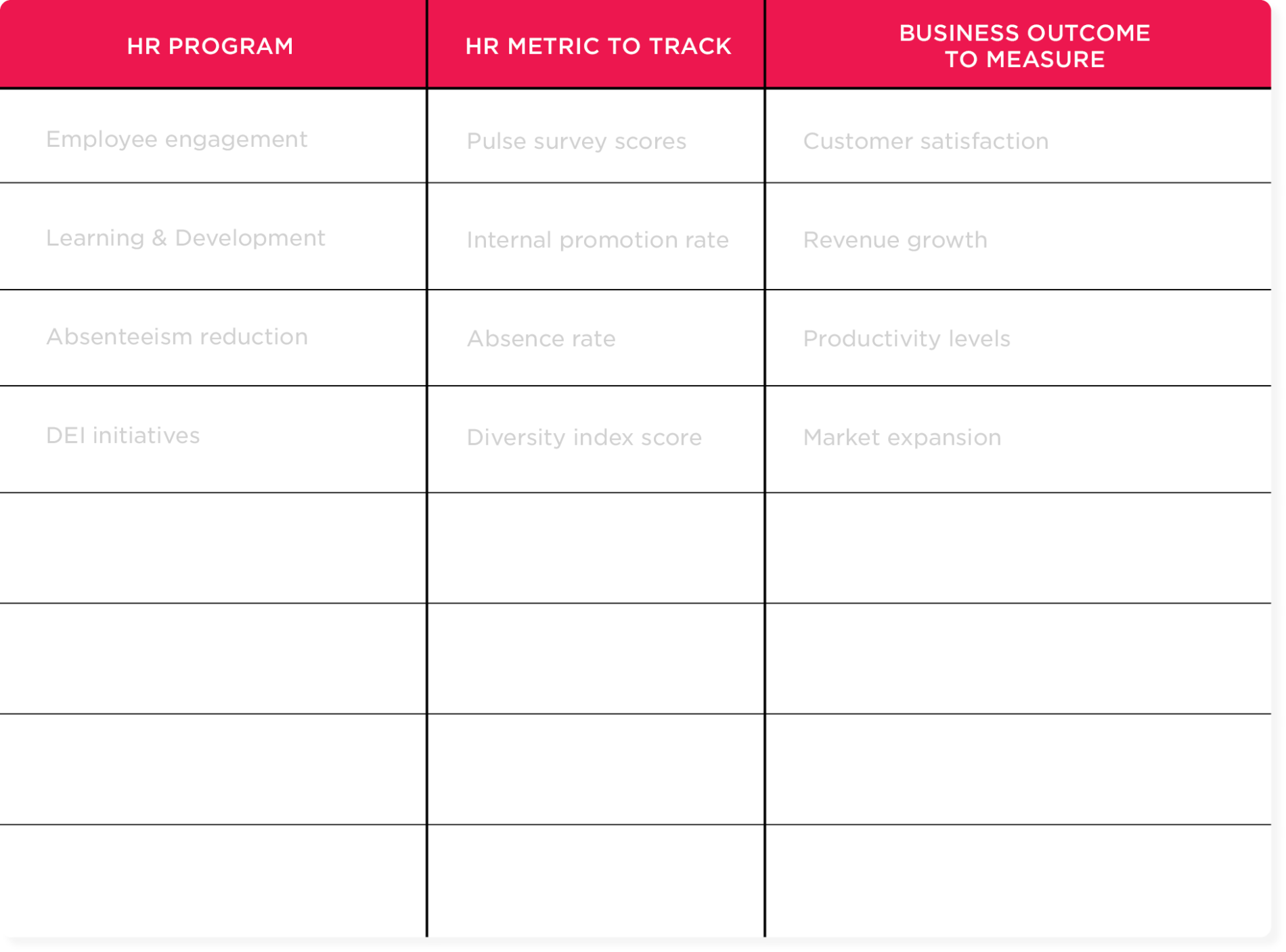
Practical strategies for maximizing impact
When operating with limited resources, choosing where to focus your efforts is critical. Triage, a powerful decision-making tool, can help HR teams prioritize their activities based on value and urgency. This method also allows stakeholders to participate in decision-making, helping them detach from lower-priority projects and shift their focus toward programs that truly impact the business.
Remember:
- Value is defined by what stakeholders appreciate. Sometimes, that’s just the CEO; sometimes, it’s a 20-person committee. Smaller companies are more likely to have a single point of decision.
- Low-value work doesn’t mean it’s unimportant, just that there are higher-value opportunities to focus on first.
Activity: Prioritizing for maximum ROI
Lean HR teams often have ambitions that exceed their current resources. That’s why prioritization is essential—not everything can be tackled at once. The impact versus effort matrix is an excellent tool for this.
Step one: Prioritizing HR programs
- Plot the HR programs that you’re currently managing on the graph
- Categorize them based on their urgency (y-axis) and value to the business (x-axis)

Now that you have your HR programs mapped on the graph, you can easily visualize their priorities based on these priority categories:
- Urgent and valuable → If your program lands at the top right of the graph, then this is a high-priority program for you. These are the “do it now” programs you want to start immediately and make sure they get the resources they deserve.
- Not urgent but valuable → If your program lands at the bottom right of the graph, then you should think of placing this program on a roadmap so you will have visibility and a start date for planning.
- Urgent but not valuable → If your program lands at the top left of the graph, then you can decide to wait until you have the capacity to start this program. You may eventually need to decide whether to drop the program completely.
- Neither urgent nor valuable → If your program lands at the bottom left of the graph, then you can think about removing this program from your HR activities altogether.
Step two: Find data points for the business impact
Data plays a crucial role in HR alignment with business goals. So when adding data points to support your HR programs, be sure to think in terms of metrics like retention savings, customer satisfaction scores, and productivity gains to clarify HR’s value.
Complete the table below by filling in your HR priorities, the business impact it drives, and the supporting data. If you don’t have supporting data yet, identify what data you could track to measure this impact.
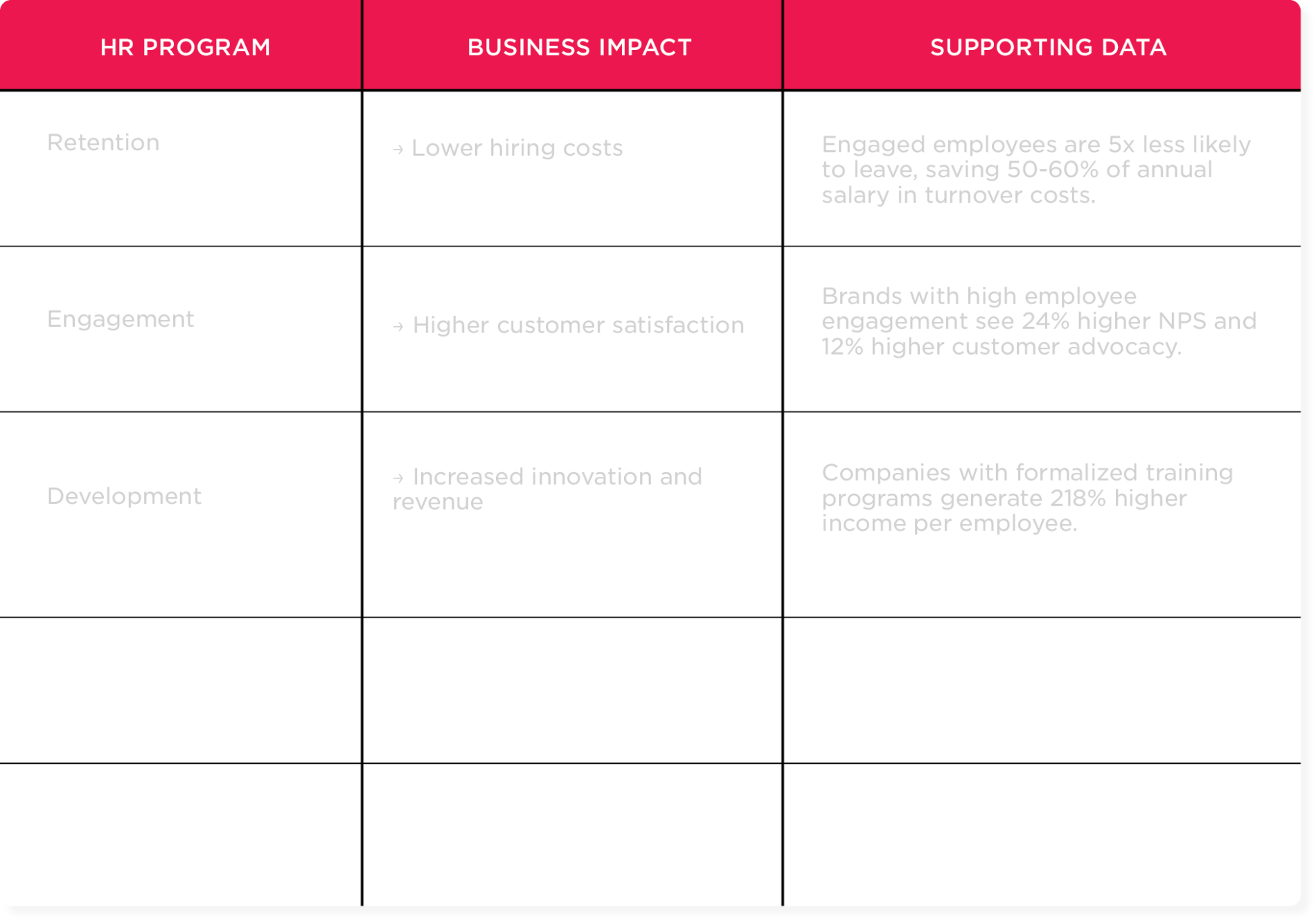
<<Download the workbook in document format to start your alignment strategy.>>
Positioning HR as a strategic partner
HR’s ability to drive impact depends on its position within the organization. By positioning HR as a true strategic partner, HR leaders can influence decision-making, secure resources, and ensure that people strategies drive measurable business outcomes.
Activity: Building cross-departmental partnerships
To move beyond administrative tasks and proactively align their programs with business objectives, you will need strong cross-functional collaboration, clear communication, and the ability to articulate HR’s impact in ways that resonate with leadership and other departments.
This activity will help you gain clarity on where to best place your efforts for cross-departmental partnerships.
Step one: Driving influence as a lean HR team
Identify how HR can collaborate with other departments to achieve shared goals.
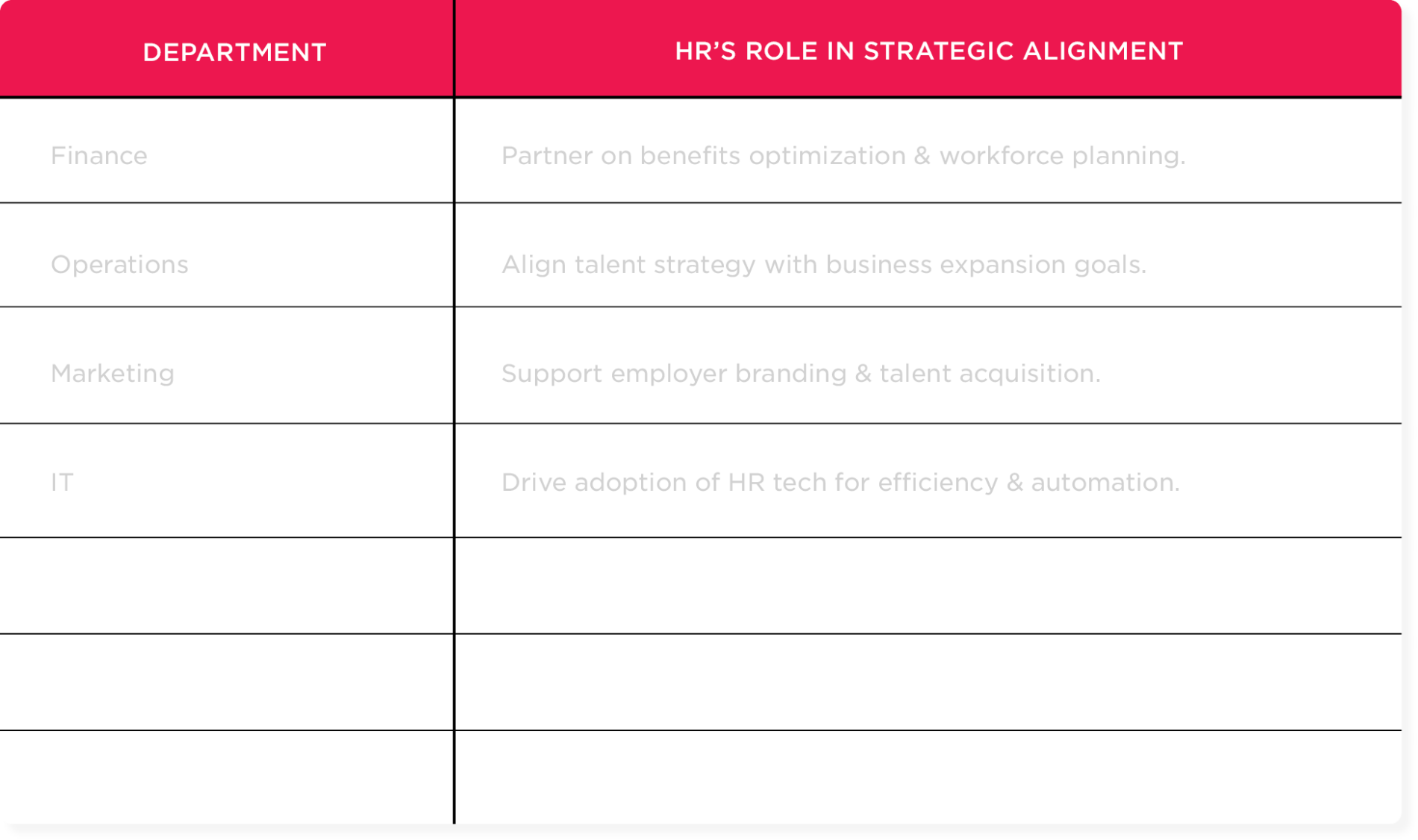
Step two: Managing prioritization and change resistance
Some people or teams may struggle with change when HR prioritizes work strategically. It’s HR’s role to guide stakeholders through this shift by fostering alignment, and ensuring that initiatives are seen as part of a long-term strategy rather than abrupt changes.
Common reactions to prioritization:
- People may feel their projects are being “taken away”
- People may feel rejection if their programs get placed on the roadmap instead of acted on immediately
- Teams may struggle with the loss of pet projects or responsibilities
Here’s a good way to handle it:
- Acknowledge the loss. Understand that some people feel personally invested in certain programs.
- Give people the “next best thing.” If a project is deprioritized, help people find another high-value initiative to contribute to.
- Explain the long-term strategy. Frame road mapping as a strategic pause to gather resources and more information rather than a rejection.
When managing resistance, HR’s biggest wins sometimes come from framing its work in business terms and gaining allies in leadership. Here are some business strategies you can use to influence leadership and teams and position HR as a true strategic partner:
- Leverage the right voices. Some leaders are resistant to change. Instead of forcing influence, identify who they listen to and work through them.
- Recruit your naysayers. Resisters are often highly engaged with the issue. Ask them, “What would need to be true for you to get behind this initiative?” This can help flip an opposing leader into a constructive design partner.
- Use “even over” discussions. Ask: “Would you rather have X even over Y?” This shifts focus toward prioritization rather than outright rejection.
- Avoid skill stagnation. Lean teams tend to keep people in their expertise zones, which can lead to burnout and disengagement over time. Make room for growth and cross-training. This keeps the job interesting and makes it easier to adapt should the team get any leaner.
- Outsource when needed. Outsourcing might be a strategic choice if an initiative delivers high value but exceeds HR’s internal capacity.
Step three: Thinking in prioritization terms
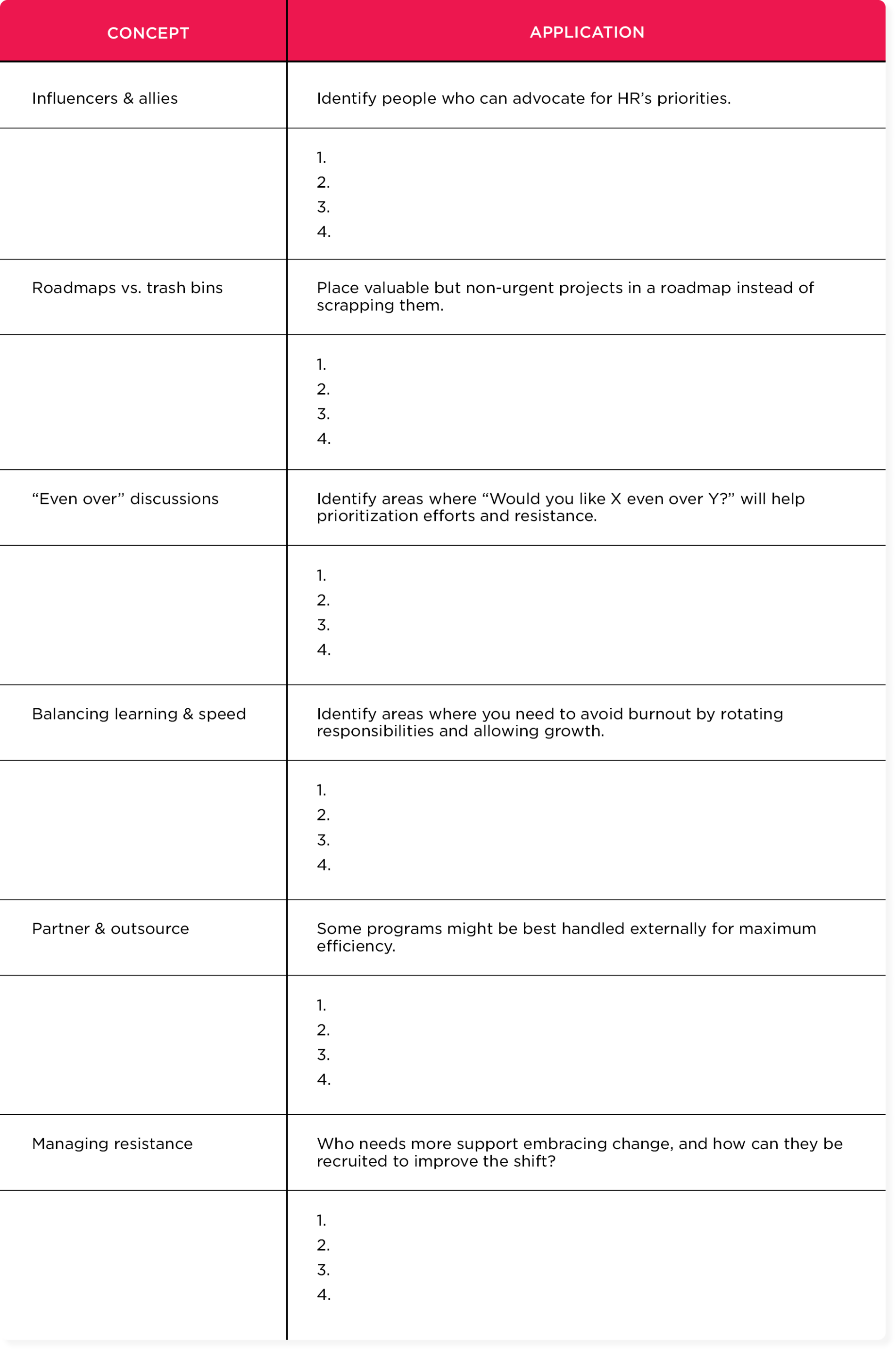
<<Download the workbook in document format to start your alignment strategy.>>
Reflections and roundup
Activity: Key learnings
Take a moment to reflect on the insights from this workbook. What are your top three takeaways?
Step one: Fill in your responses below:

Recommended For Further Reading
Step two: Take the next steps
Identify three immediate steps to start aligning HR strategy with business goals.

Moving forward
This workbook was designed to help you align your HR strategy with your organization’s business goals. After all, when your people are engaged and aligned, your business thrives.
By aligning your HR programs with business goals, you are elevating awareness of how your work impacts the organization. With the activities in this workbook, you can document your HR programs, making tracking, measuring, and communicating their success easier. When the time is right, you can celebrate the impact you make with leadership, employees, and stakeholders.
Here’s to alignment and driving business success with your HR programs.
<<Download the workbook in document format to start your alignment strategy.>>
Want to watch the webinar?
